As usual, we had a fantastic crew of technicians working at Lucky Peak this fall who made our monitoring project possible. Read below to hear our tech takes from each of our three projects. You can read the whole article, or skip ahead using these links to read about songbirds, diurnal raptors, and owls.
The Morning News
By Lesley Rolls
Each year as summer approaches its end and the days begin to get colder and shorter, there are mixed emotions of sadness and excitement for each birder. It is the end of the breeding season but then we welcome fall migration. On the heels of a very productive fall 2020 season, Lucky Peak’s 2021 Songbird Crew was filled with optimism as we kicked off the banding season July 16th with lots of diversity and above average numbers for the time of year.
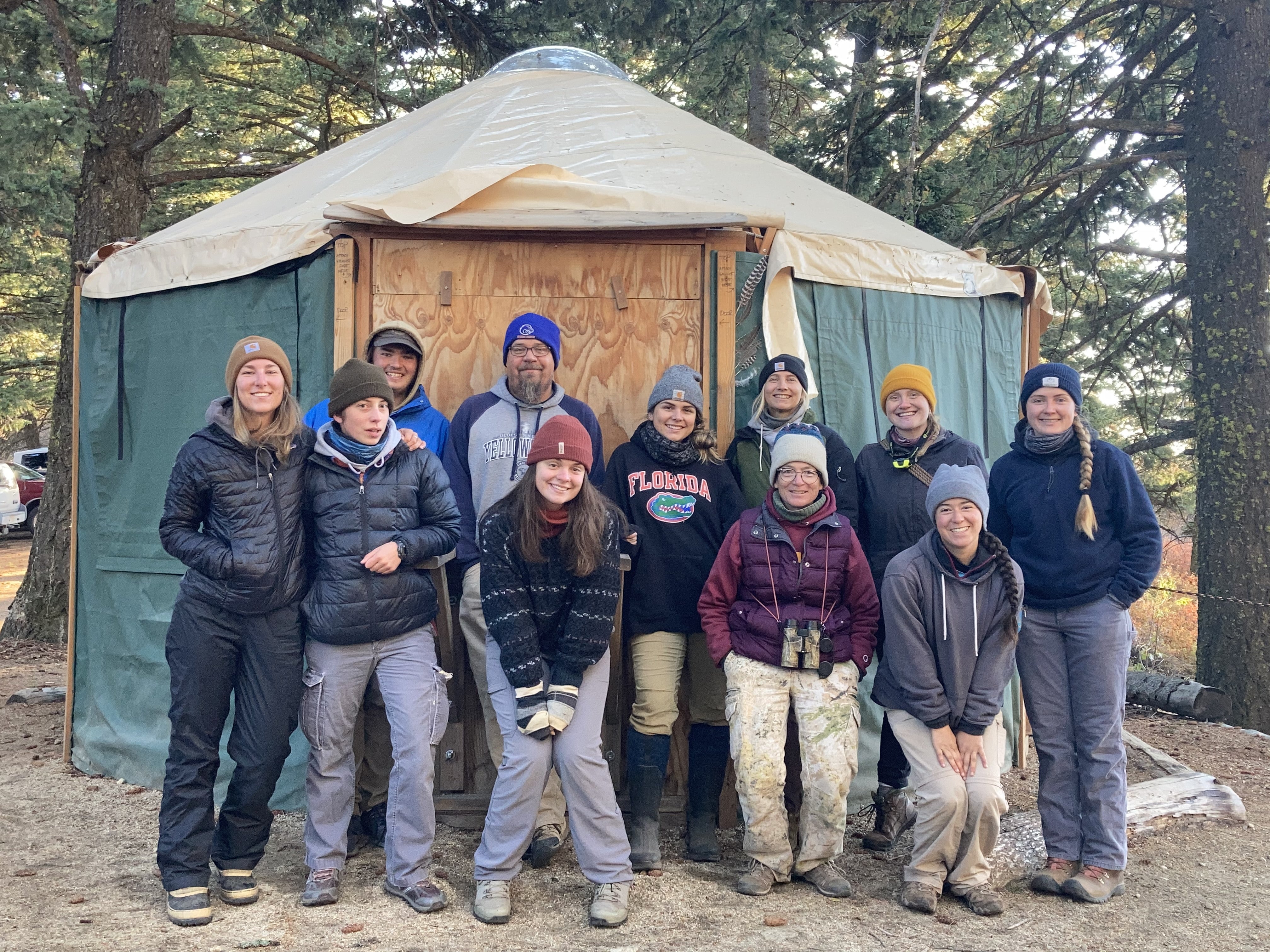
We expected a busy season, but that did not turn out to be the case.
IBO’s 2017 songbird season previously held the record low with 4,126 passerines banded. Unfortunately, this season’s numbers slipped below that record with a “whopping” total of 3,993 passerines banded.
The station hit the typical lull in early August, averaging approximately 40 songbirds per day. But then the first cold front pushed into the valley in early August and we encountered the first big day with 84 birds within the first two net runs. Numbers were expected to rise in the weeks following but returned to the previous lows.
The first half of the season was filled with many Black-headed Grosbeaks, Western Tanagers, Lazuli Buntings, Warbling Vireos, and various Flycatchers and Warblers.
We soon welcomed our first winter resident on August 23rd when a Townsend’s Solitaire stopped by.
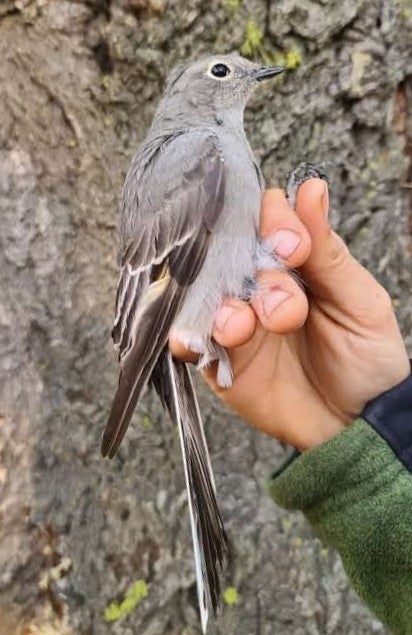
We then experienced a shift in species as September rolled around with an abundance of Kinglets, Dark-eyed Juncos, White-crowned Sparrows, and Yellow-rumped Warblers.
Check out our Top 10 banded species this season!
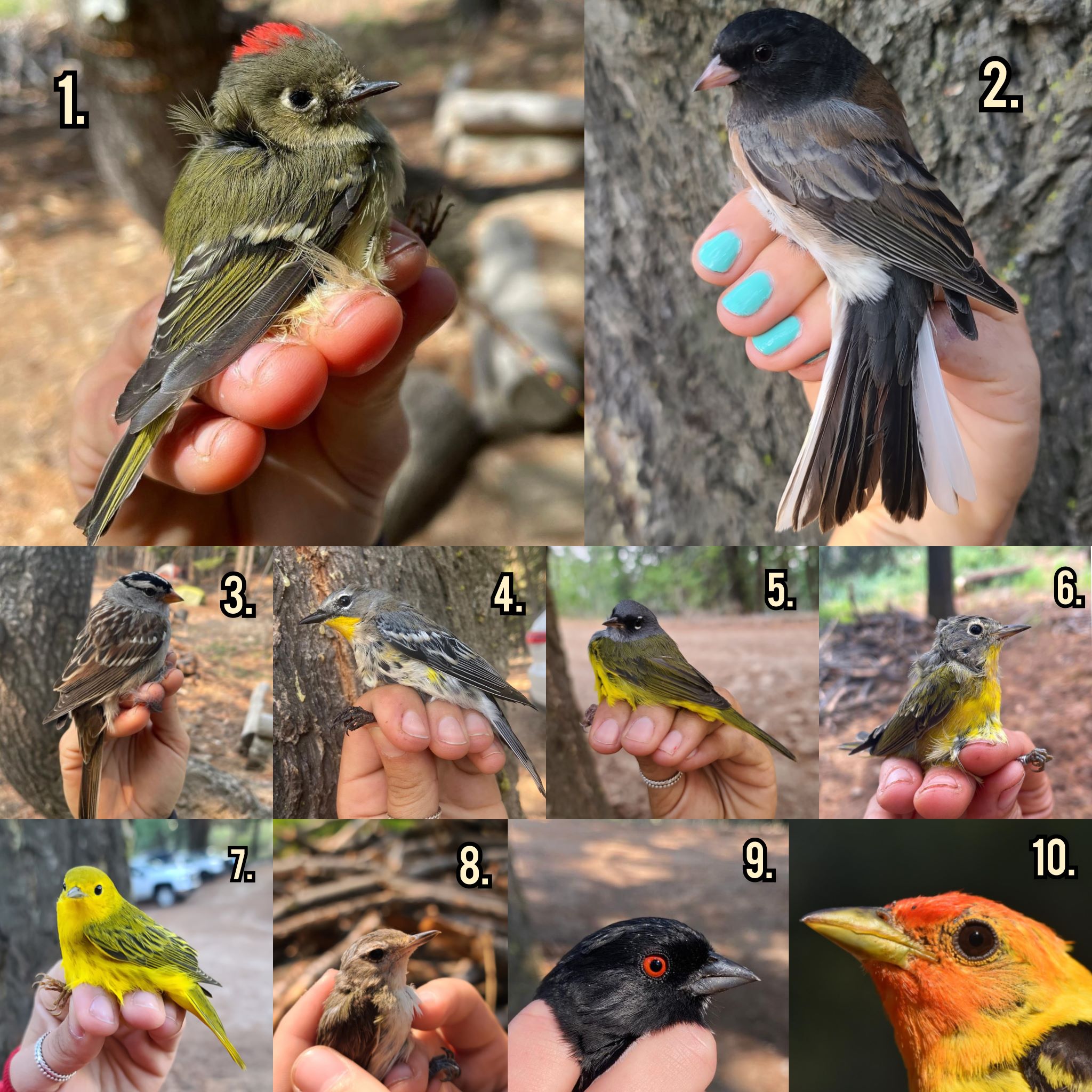
These are some of IBO’s most common species, but overall, the numbers were lower than average and resembled totals from the previous record low year in 2017. This season the station had a total of 57 species, which is about average. However, the crew did NOT have a Cassin’s Finch this fall which was a surprising anomaly and station first!
Even though it was a slower season at Lucky Peak, the crew did have some exciting and new captures…
Within our first week, we banded the station’s 3rd Bewick’s Wren, 9th Green-tailed Towhee, and 14th Lesser Goldfinch.
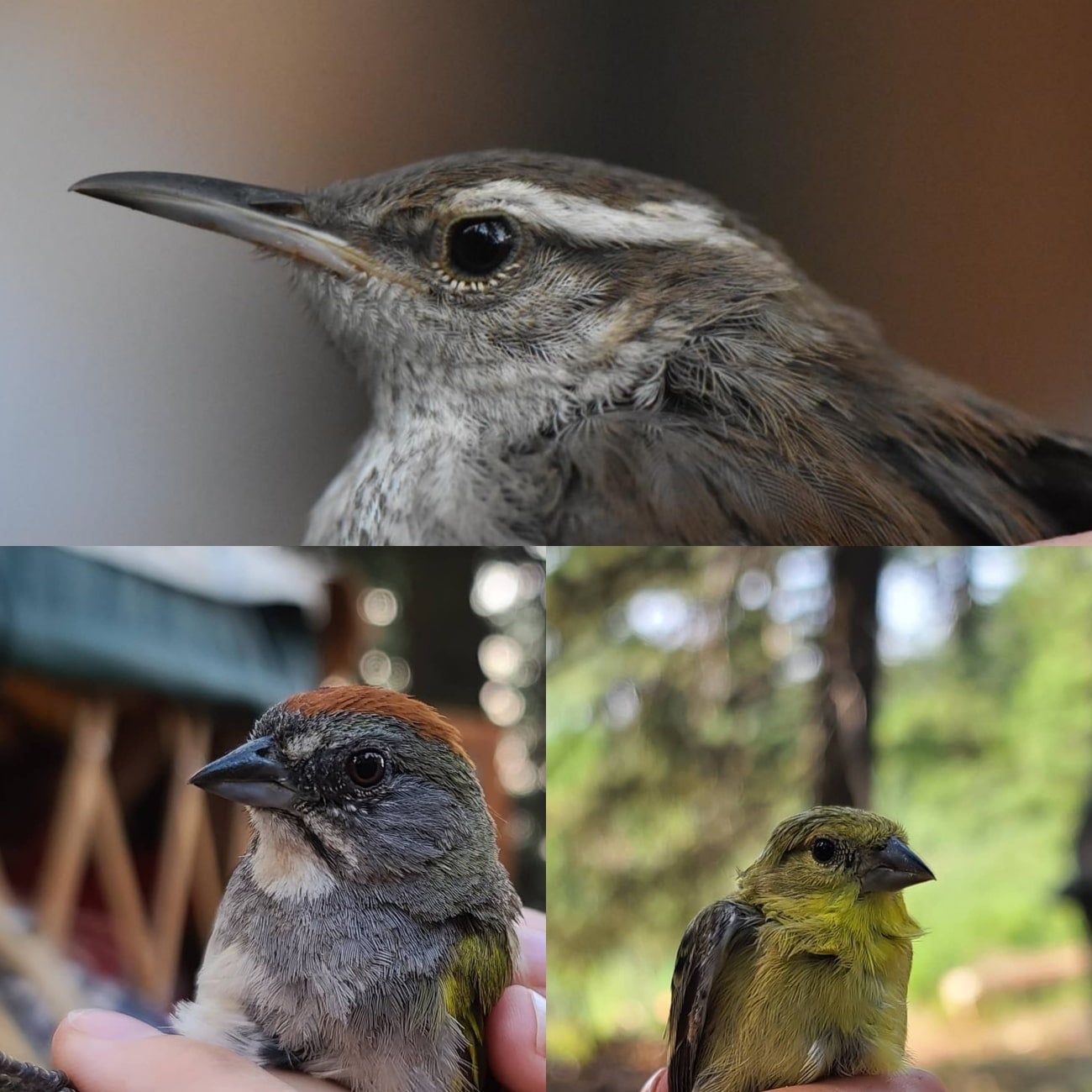
On September 16th the crew caught a STATION’S FIRST Williamson’s Sapsucker, a hatch-year female!
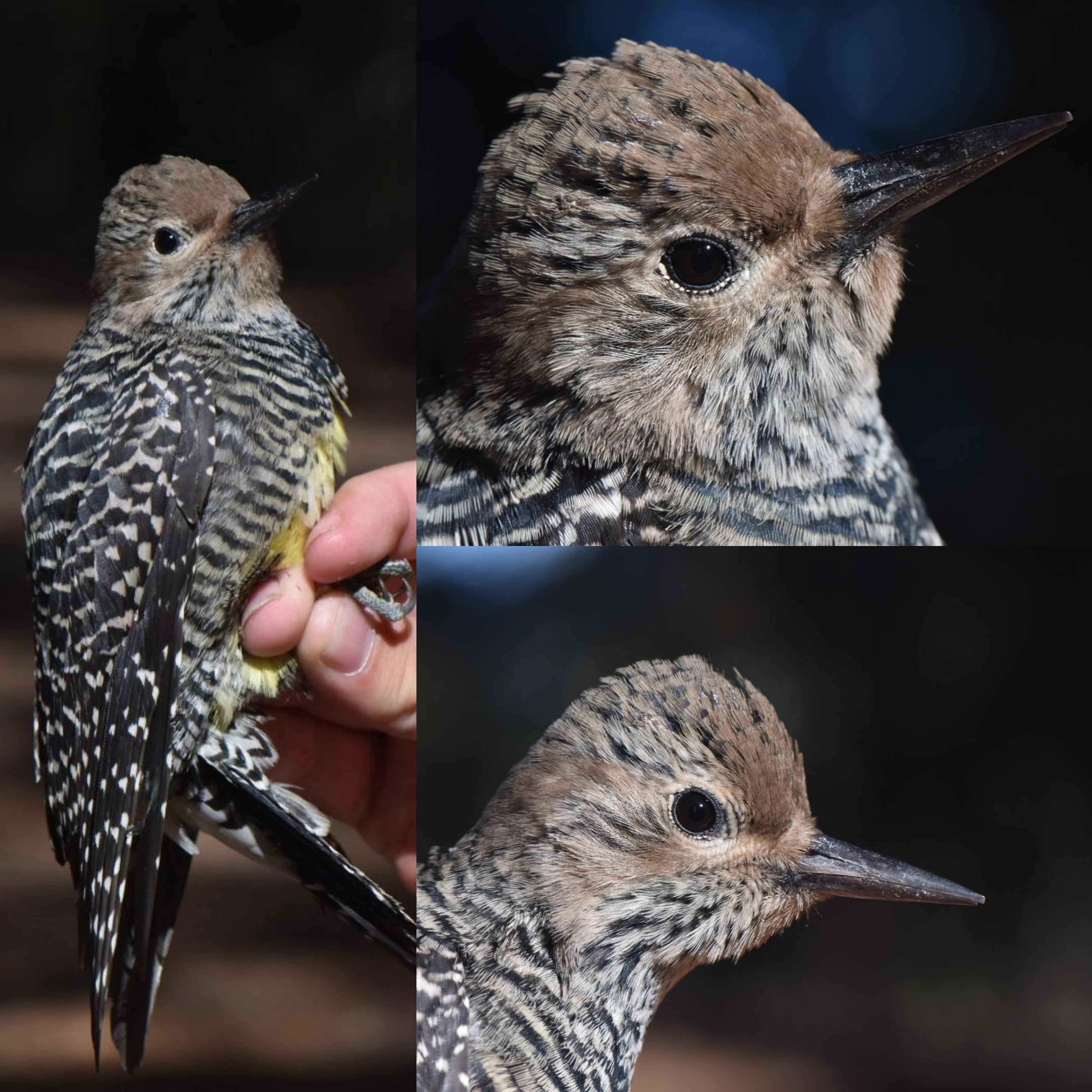
Even a Pygmy Owl surprised us one morning!
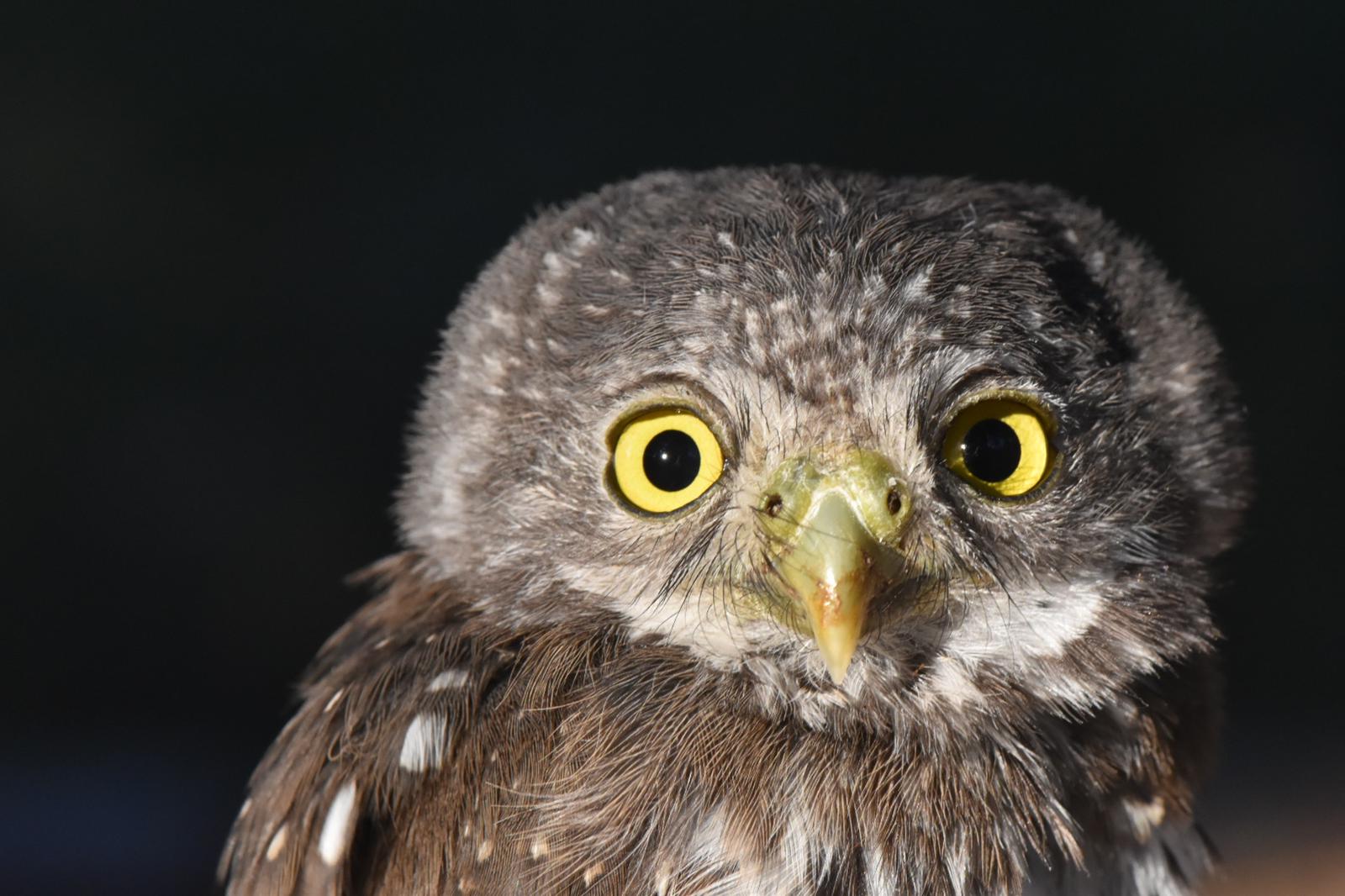
Other notable captures were a Lark Sparrow (2nd ever at Lucky Peak), our 5th Blue-headed Vireo, 6th Black-throated Blue Warbler, 8th Black-throated Gray Warbler, 9th Tennessee Warbler, and 14th American Redstart.
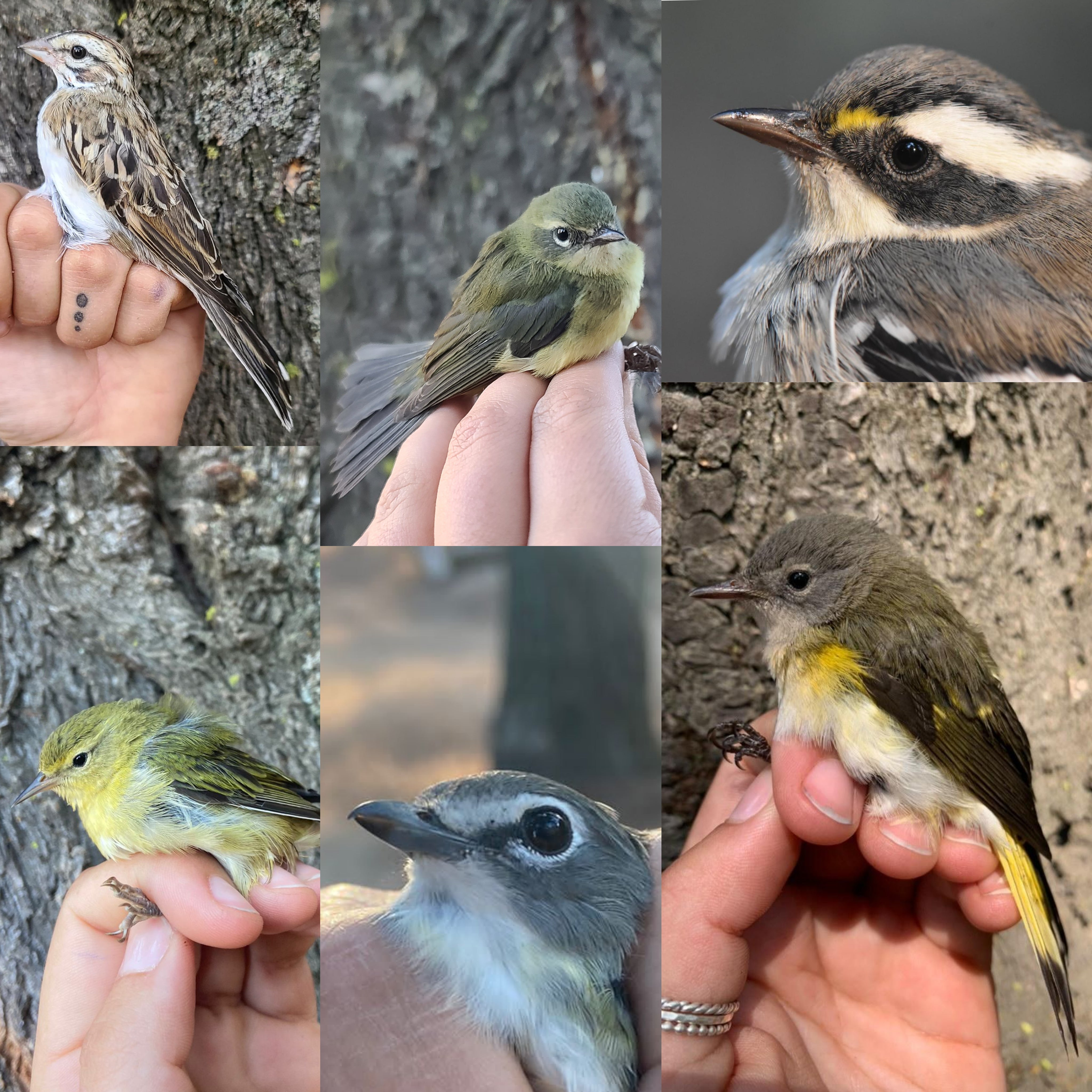
On October 2nd anxiety levels were high as the IBO crew were joined by 2 banders from University of Montana Bird Ecology Lab (UMBEL) at the Peak to test for their North American Banding Council certification and we were so excited that everyone got certified! This was also the same day the station hit the highest day of the season with 110 individuals banded. During the hustle and bustle of the certification, the crew had an exciting visit from the first and only Golden-crowned Sparrow of the season! In the last couple of weeks of monitoring, numbers continued to drop and we had a total of 28 birds on our last day of banding.
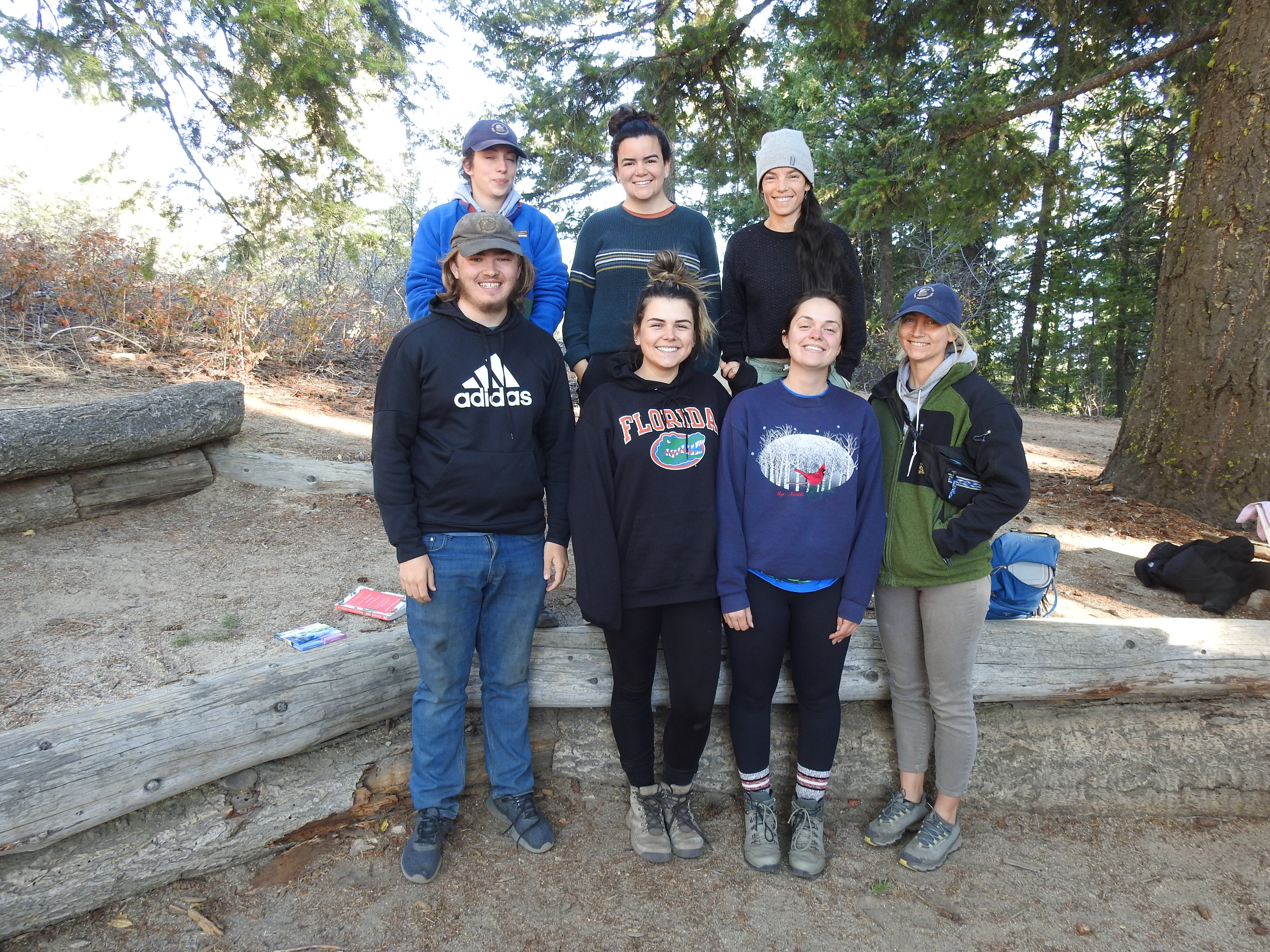
The shockingly low total for this season leads us to question…
…why did this happen and what should we expect in future years?
The overall drop in numbers we saw in 2021 can be due to a multitude of reasons. When comparing the last 5 years of data we can see large fluctuations in our year to year capture rates. This could be due to shifting migration routes but could also potentially be caused by environmental pressures. For example, this was a noticeably hotter and drier year in much of the West, along with increased fire activity. These factors could have a part in impacting breeding success and/or migration through effects of food availability, nest failures, and the overall health of the individual. Another factor that we’ve been considering is that during the fall 2020 migration, biologists documented a large songbird mortality event in the southern Rockies, seemingly caused primarily by unseasonably cold/snowy weather – could this have affected the populations we monitor passing by Lucky Peak? We had one of our best capture rates yet during 2020 but did some of these individuals succumb to this event after we had counted them? It’s hard to make any firm conclusions without understanding the full picture, but our continued monitoring at Lucky Peak allows us to analyze these fluctuations and compare year to year factors that may be impacting these fluxes of highs and lows.
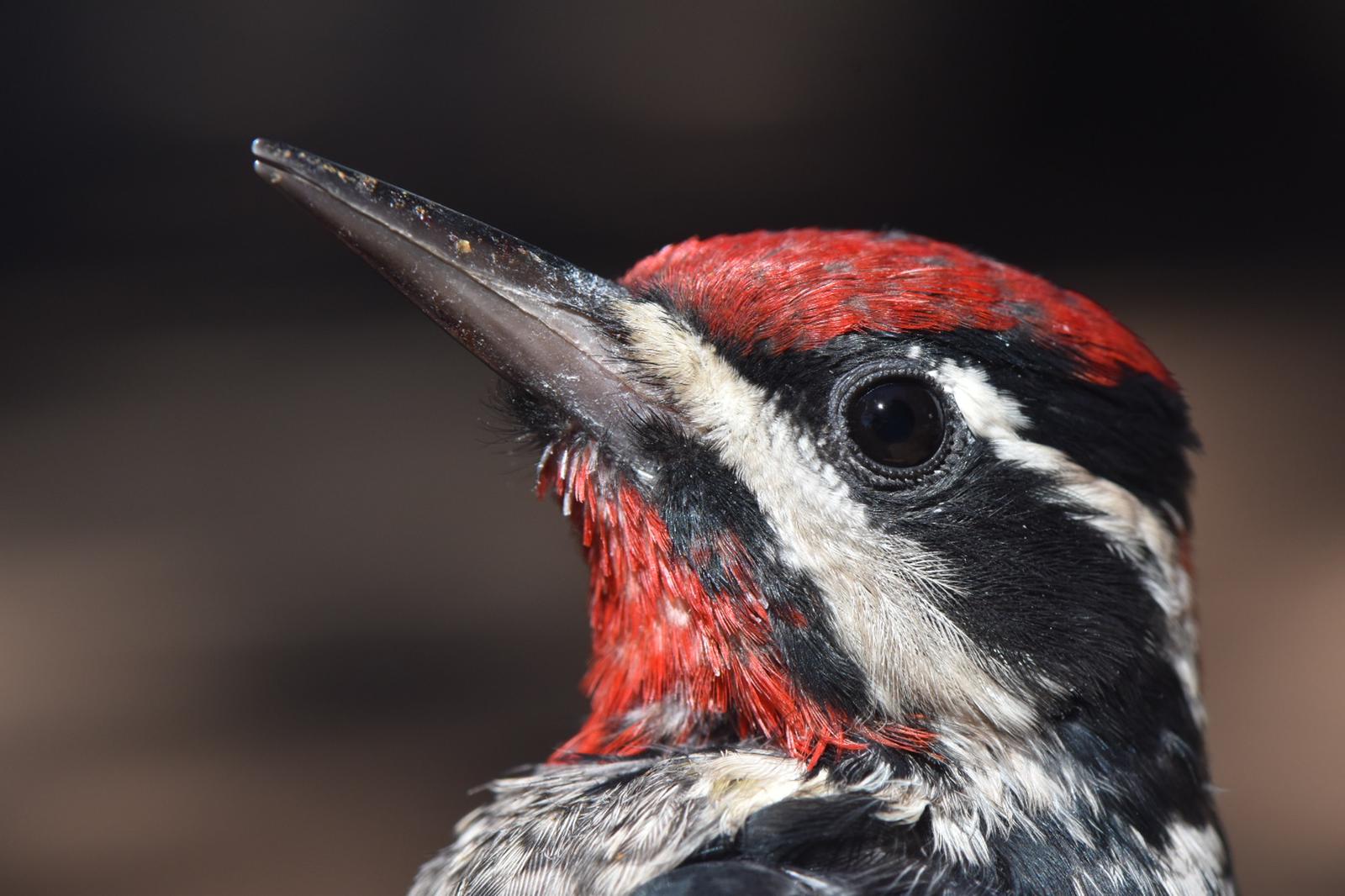
As we say goodbye and wish our fall migrants good luck on their journeys south for the winter, we hope for a more productive year in 2022. The Lucky Peak Crew would also like to give a shoutout to “Pip” the Turkey, “Pepto” the Red Squirrel, and “Penny” the Praying Mantis. The season would not have been the same without them!
Thank you to all our visitors and volunteers. We hope to see your smiling faces again next fall!
The Afternoon News
By Lesley Rolls, Kate Maley and Jessy Wilson
This year marked the 29th season of IBO’s Raptor migration counts and banding. Boise Peak banded 438 raptors and Lucky Peak banded 502 raptors giving us a total of 940 this season, which was a little below average. Our Hawkwatch Crew counted a total of 5,492 throughout the season. Though the overall numbers weren’t sensational, both stations had excellent years with rare and exciting birds!
Kate Maley spent her fall season banding migrating raptors in solitude at our IBO’s Boise Peak Station. Here is a glimpse into the incredible season she experienced.
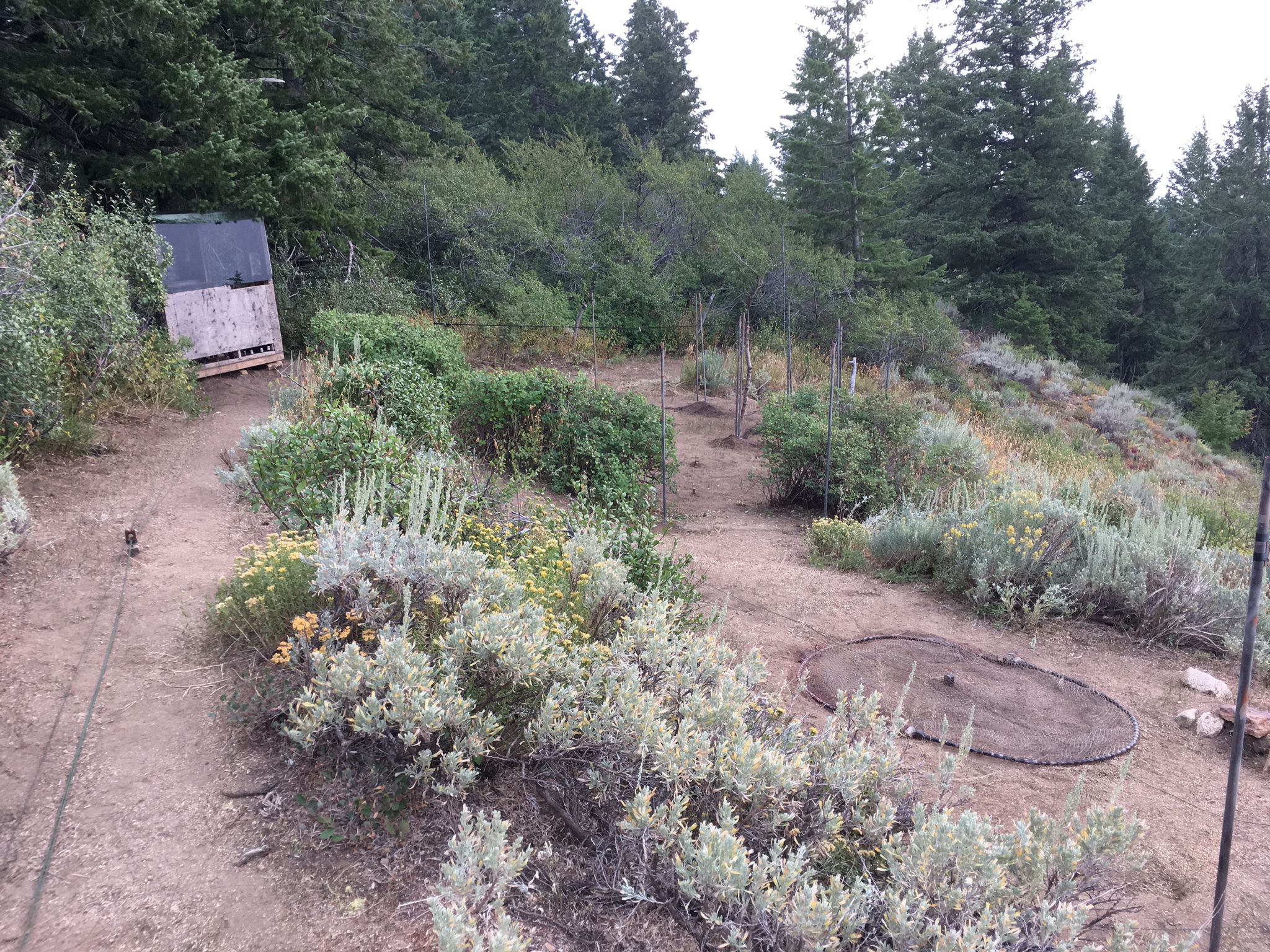
To run a raptor banding station during the fall is to get a front seat to the phenomenon that is diurnal raptor migration. I was privileged to watch from my perch atop Boise Peak as these apex predators followed their instincts south, taking advantage of favorable wind conditions, moving expertly through the topography, and occasionally taking a break to hunt. Even the birds that weren’t banded were spectacular to see: Red-tails hovering as they hunted the sagebrush-covered mountainside, the local Golden Eagles performing acrobatic feats as they put the next generation through their paces, and American Kestrels snatching grasshoppers from midair and eating on the fly.
Of course, it is pretty hard to compete with the awe of having a bird in hand.
One especially memorable 24 hours began on an afternoon in mid-September with the capture of a young female Prairie Falcon. Big falcons are always exciting to catch, but this bird was particularly special as she was not only Boise Peak’s first Prairie Falcon of the season but also a first ever for me.
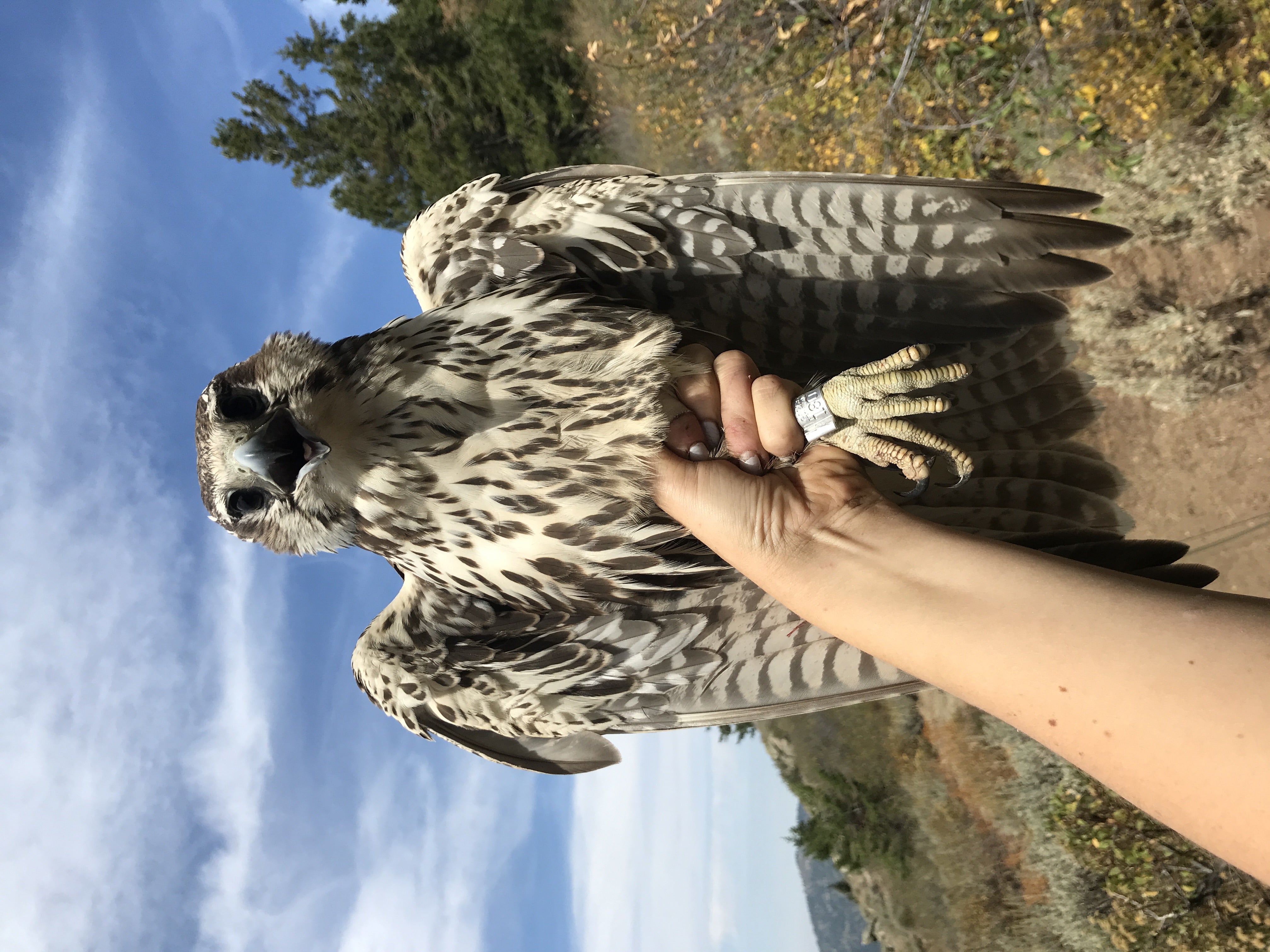
I remember thinking that that was it, I had seen all the birds I could reasonably have hoped to see in the hand during my season on the Boise Ridge. Well, except maybe a Golden Eagle.
But that was never going to happen… I don’t think I’ve ever been so pleased to have been so wrong!

Though I figured I was now surely destined to catch only Sharp-shinned Hawks for the rest of the season (though I would not have been complaining!), my luck proved intact the following afternoon when I caught a Red-shouldered Hawk. I couldn’t believe it! But it was hard to argue with the characteristic red on the upper wing and white “commas” at the base of the outer primaries.
It wasn’t until after I had released the bird that I found out it was only the second caught in IBO’s 29 years of banding.
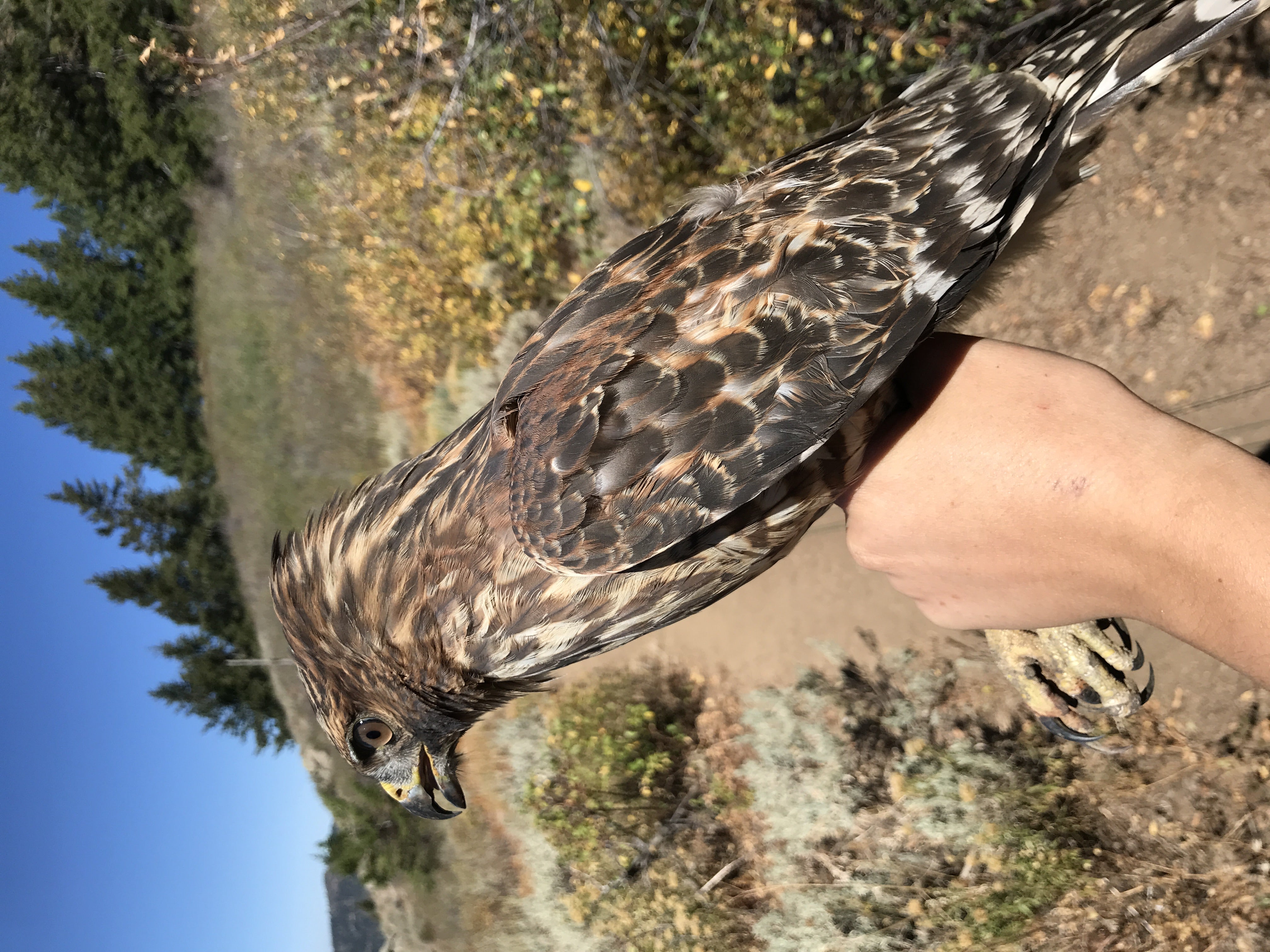
Jessy Wilson, our lead bander at Lucky Peak this fall, had the pleasure of banding some special birds as well. Here is her story.
I have seen a few Broad-winged Hawks in the hand, but this fall I caught my first one – a lovely hatch year individual.
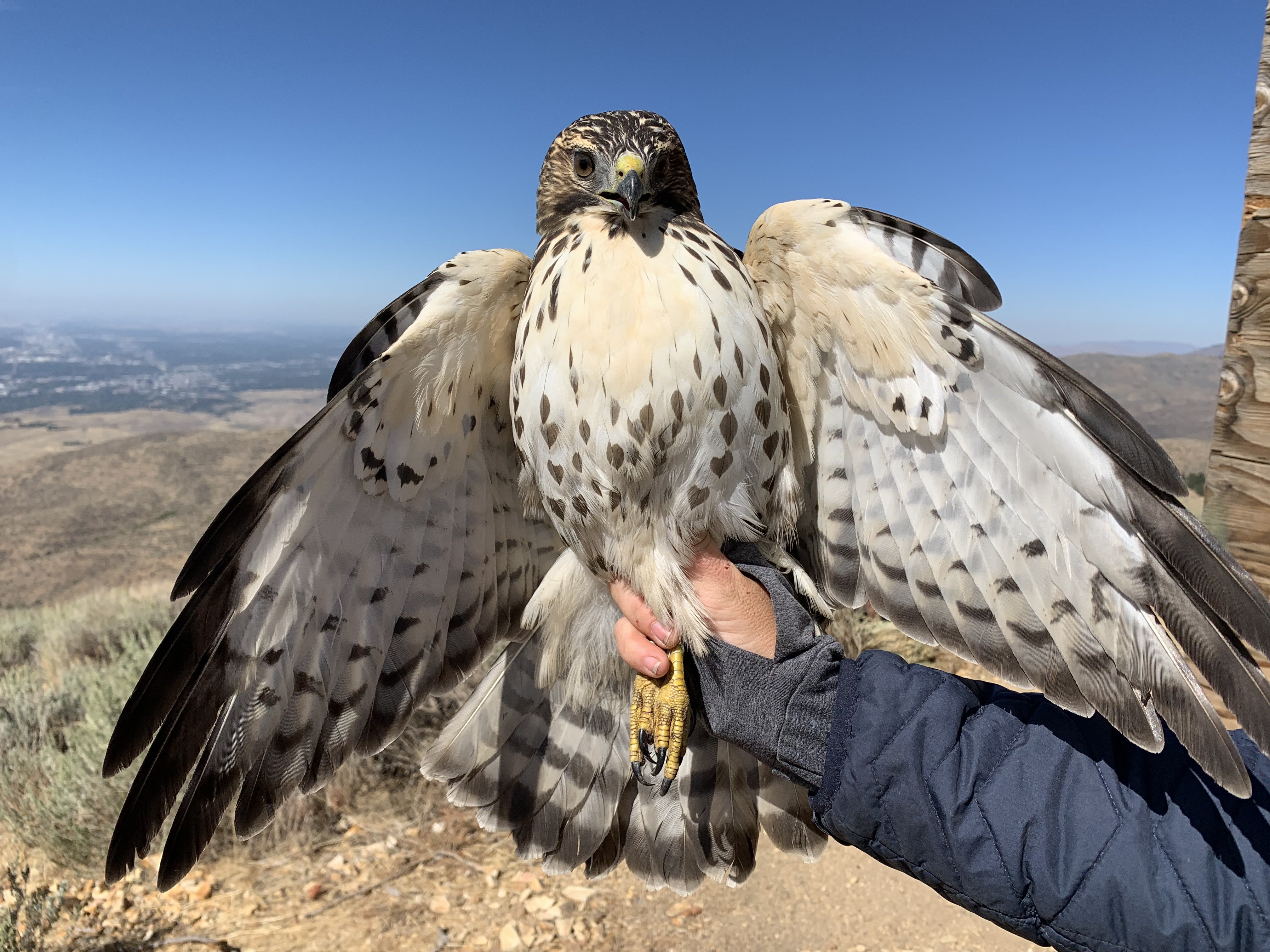
Another special catch was a healthy adult female Northern Goshawk. Adult goshawks are rare captures on the Boise ridge, and to catch such a large and fully mature adult female was nothing short of memorable.
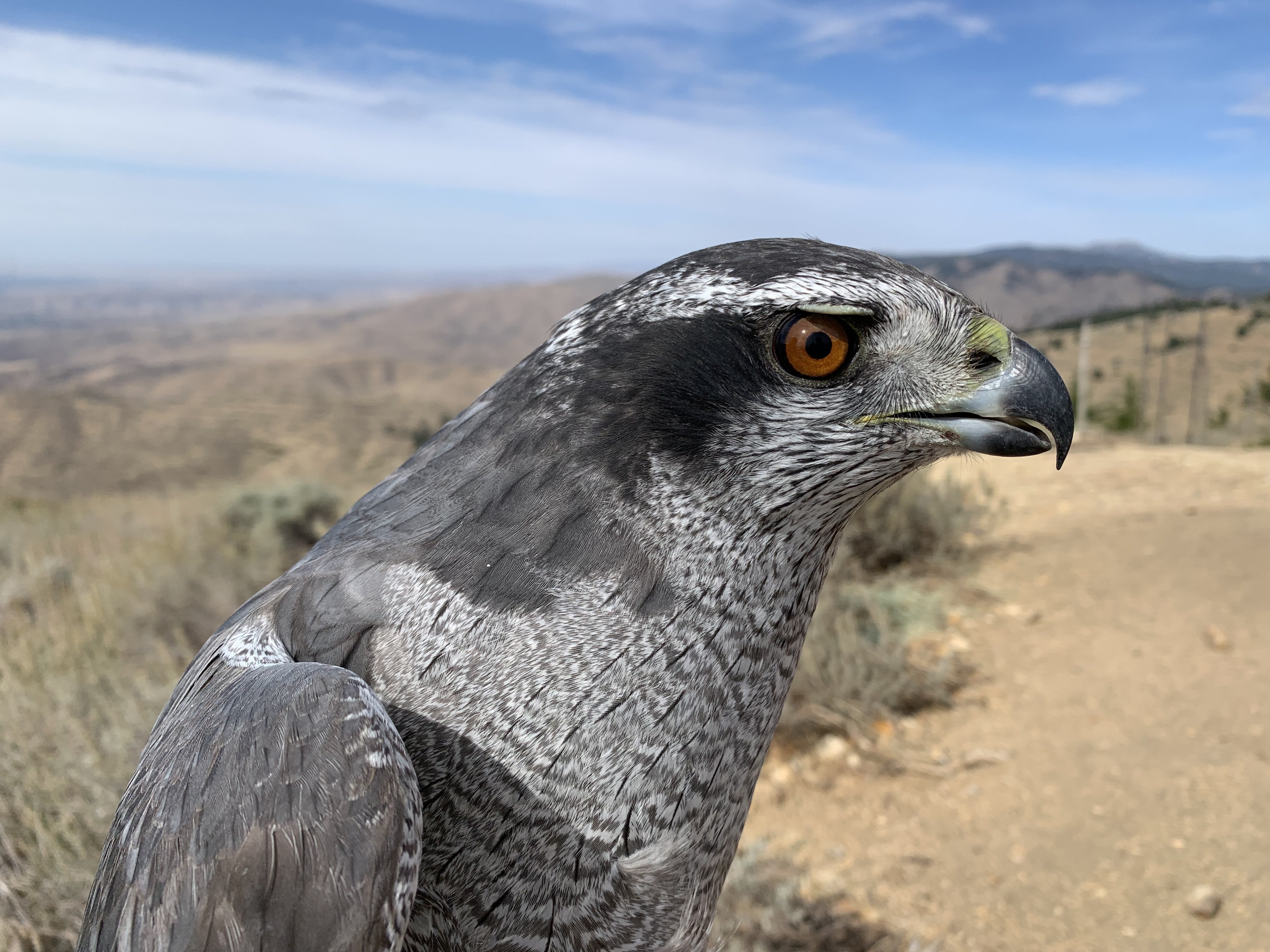
Lastly, I will never forget the day I was lucky enough to band a dark morph Harlan’s Red-tailed Hawk on my only day at Boise Peak.
This bird was gorgeous, and quite a rare catch as well!
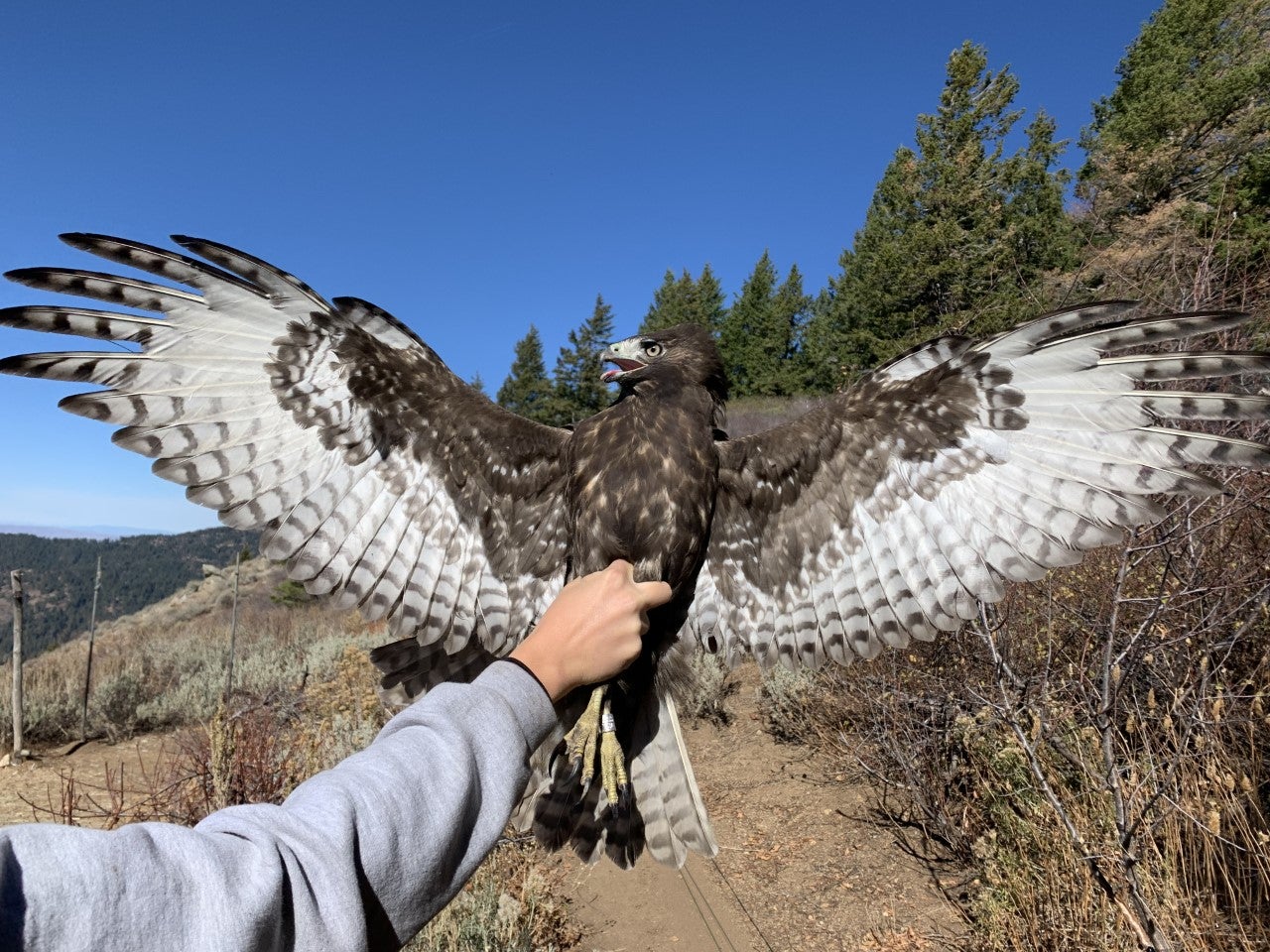
I grew up on the East Coast, so I didn’t have the good fortune to see many Western raptor species for much of my life. Once I came to run the Lucky Peak station at IBO, Swainson’s Hawks were one of the raptor species I was most excited to see. They are typically not easy to catch during migration, so I was not expecting to see a Swainson’s in any capacity other than watching them fly overhead.
To my great surprise, I was mistaken, and I caught one on a slow day in mid-September!
It was a beautiful hatch-year male, and it was one of my favorite birds I have ever had the privilege of having in the hand. Out of IBO’s 29 years of raptor banding, this was only the ninth Swainson’s ever banded. I think about this bird often, and I hope he is spending the winter somewhere south of the equator with plenty of food.
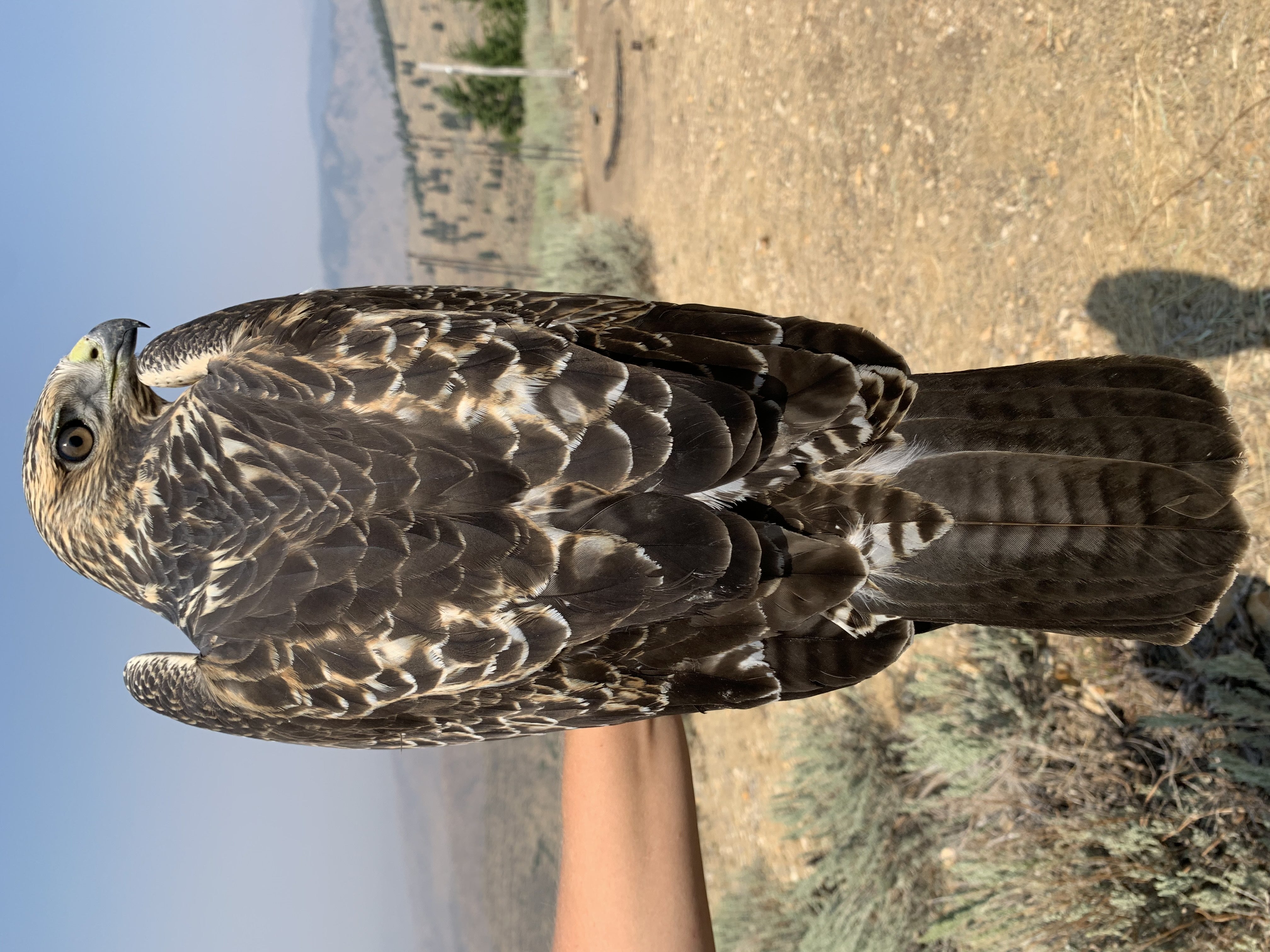
This fall was strange in a lot of ways – the weather patterns included more southeast winds than usual, the Sharp-shinned Hawks didn’t migrate through in their usual numbers, and there were a number of uncommon species banded for raptors, owls, and songbirds. We also had a big year for Red-tailed Hawks; this year, we banded a record high number of red tails (!) – more than triple the long-term average for this species, including quite a few adults and dark morphs. It was really special to see so many of these wonderful birds!
The Evening News
By Nancy Drilling
It was with great excitement that we turned on the audio lure broadcasting the Flammulated Owl (a.k.a. “Flam”) call at 9 PM on August 28th, opening night of the 2021 Lucky Peak owl banding season. None of us had ever seen or heard a Flammulated Owl before, much less handled or banded one.
As owl banders, we were enticed to come to Lucky Peak in part because IBO operates the only long-term Flammulated Owl migration banding station in the world.
We didn’t have long to wait – at 1 AM, we caught our lifer Flam! Wow! So tiny! So stinky (Flams poop a lot and it doesn’t smell good)! Such a death-grip with their talons in the net! Such beautiful plumage!
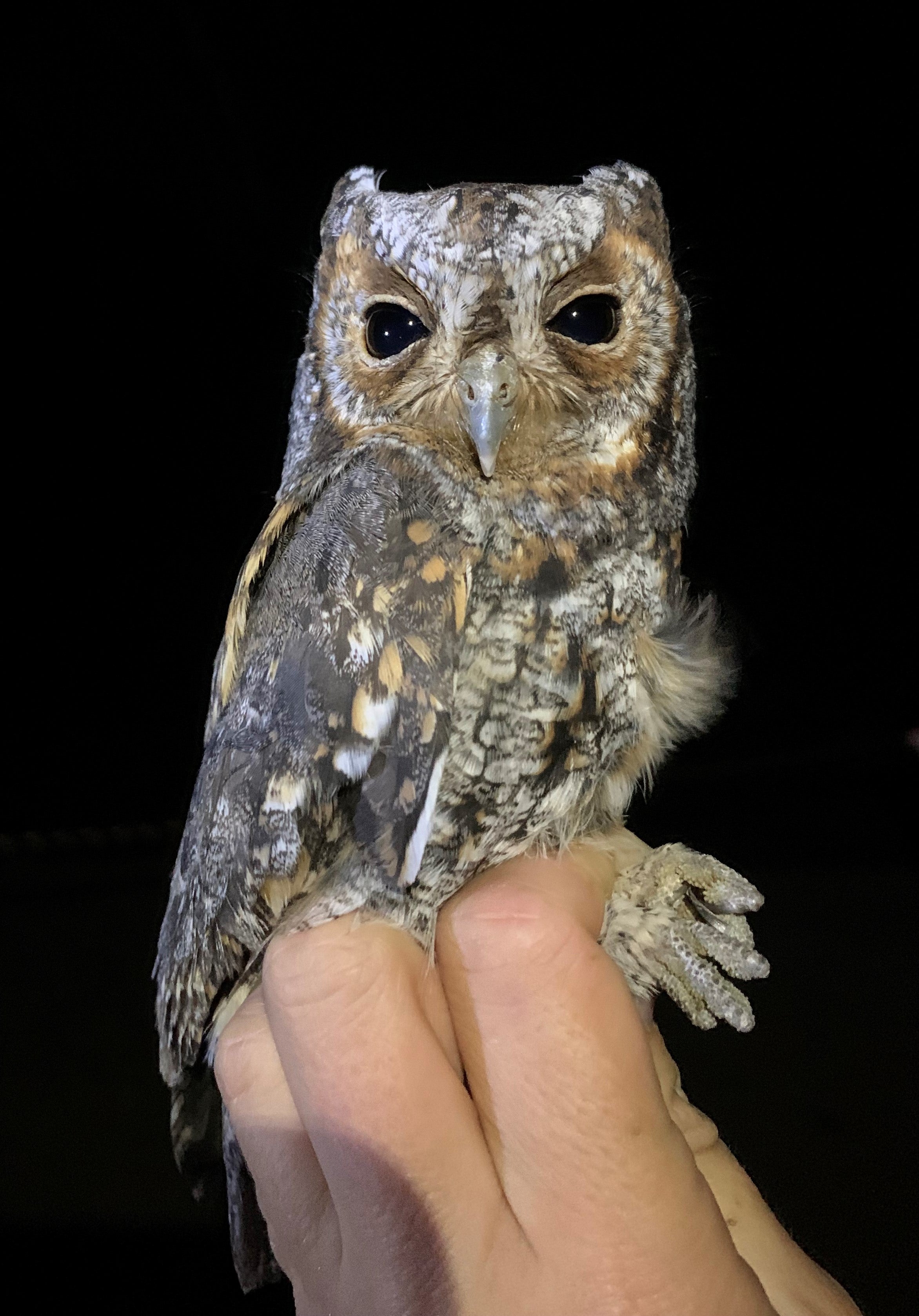
Then at 2:30 AM, four more. And they kept coming such that by September 1st we had caught 10 birds, more than are caught in entire seasons some years. Each owl just as tiny, smelly, stubborn, beautiful, and amazing as the last one. A fantastic start to the season!
We figured we had a record-breaking season ahead of us, but then reality set in.
Those birds were probably local or semi-local birds, not migrants from far away. We didn’t catch any more owls until September 6th, when migration appeared to have really started. We whiled away our nocturnal shifts doing puzzles, reading books, and admiring the distant night lights of Boise.
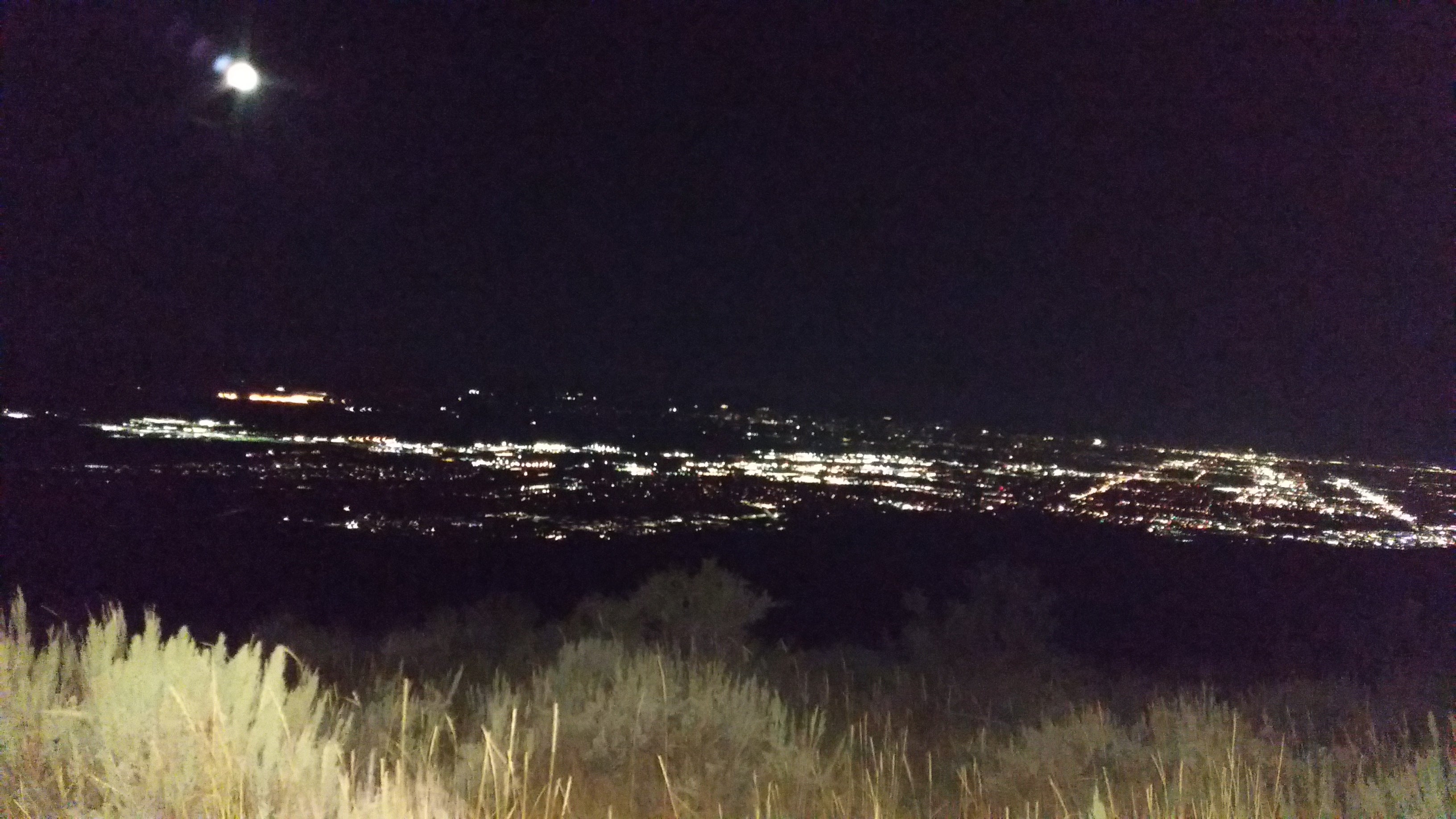
After that, we had a steady stream of birds. We surpassed the 2020 season’s total of 45 Flams on September 15th and the second highest yearly total (2016) of 67 on September 25th. By the time we stopped calling specifically for Flams on October 1st, we had reached a total of 74. We were happy – the second highest all-time total (the highest was 98 in 2013). We figured Flam migration was over.
But we were wrong again!
The Flams kept coming, even though we weren’t calling for them! On the night of October 7th – 8th, we caught eight Flams, our highest single-night total of the season. We soon found out why – a strong cold front came through during the day on the 8th, and that ended the Flam migration.
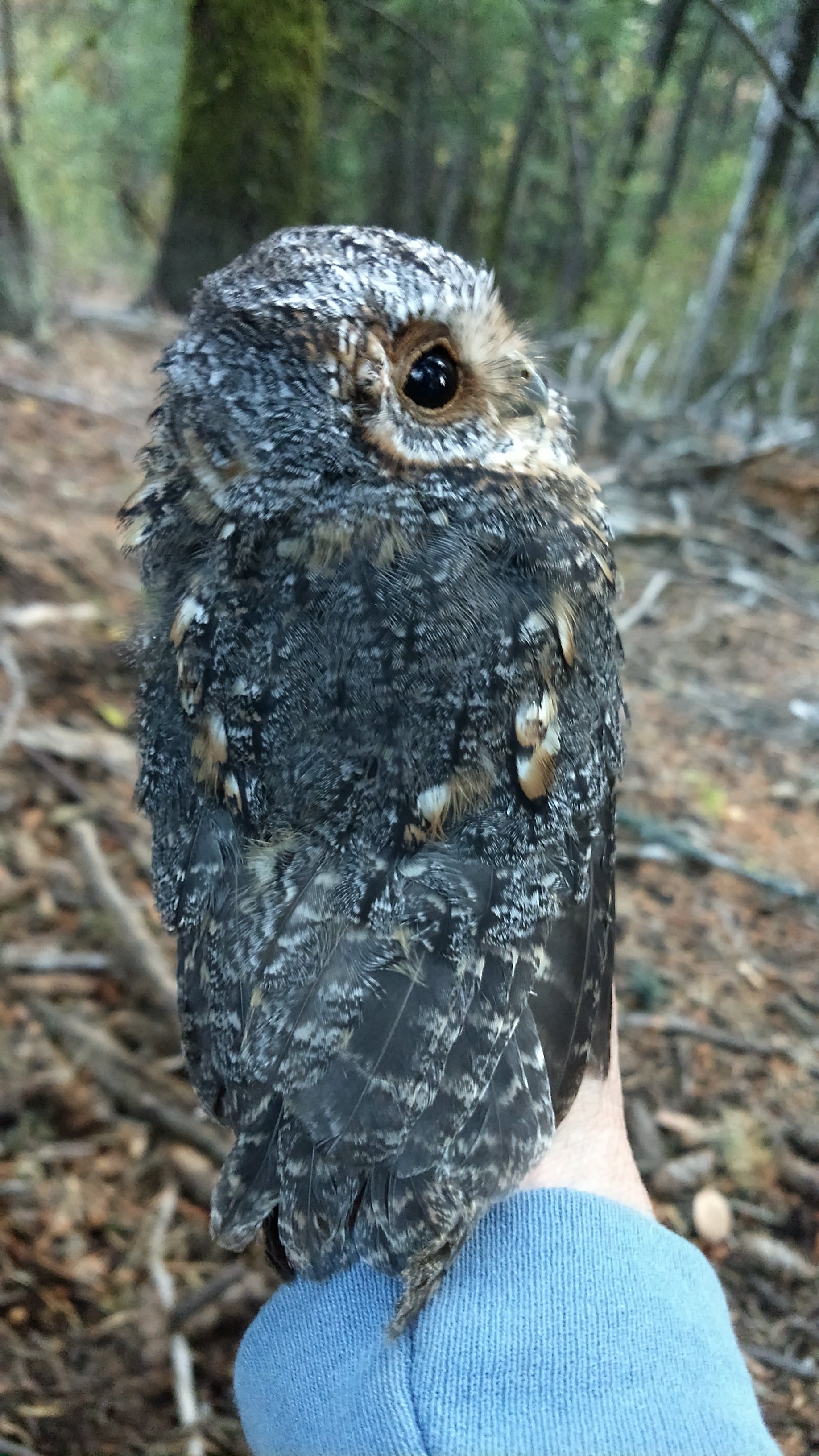
We finished the season with 87 Flams!
We banded a rehabbed fledgling that was rescued by firefighters on the Boise National Forest during the summer, raised by the Ruth Melichar Bird Center, then released at Lucky Peak.
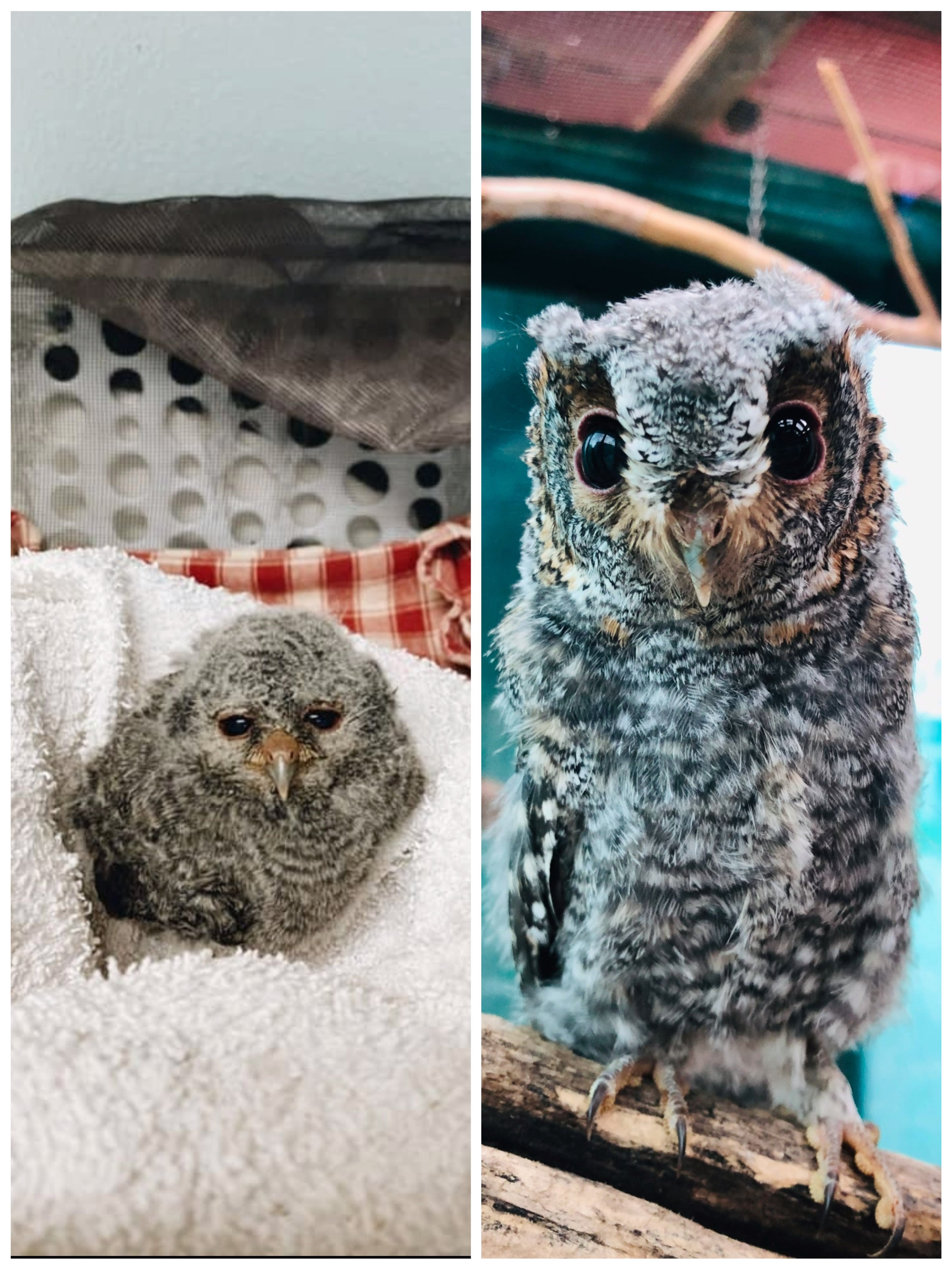
An interesting anecdote: the findings from IBO’s 2015 paper held true again this season. Almost 70% of the Flams (and more than 40% of the Northern Saw-whet Owls) were captured in the Bitter Cherry nets in between our audio lure stations. These nets (added to our station in 2011) are located in shrub habitat, not the Douglas Fir forest habitat that the two audio lure net sets are in. The nets stick up above the shrubs and seem really visible. And although both audio lures can be heard from these nets, they are not particularly close. Though this species is largely known as a breeder in open, mature forests, it could be that these dense shrubs provide a higher quality foraging habitat at this time of year.
Most years, the Lucky Peak owl banding station catches at least one or two ‘odd ball’ owls – species that we don’t target with our audio lures and this year was no exception.
Our first surprise? A Western Screech-Owl!
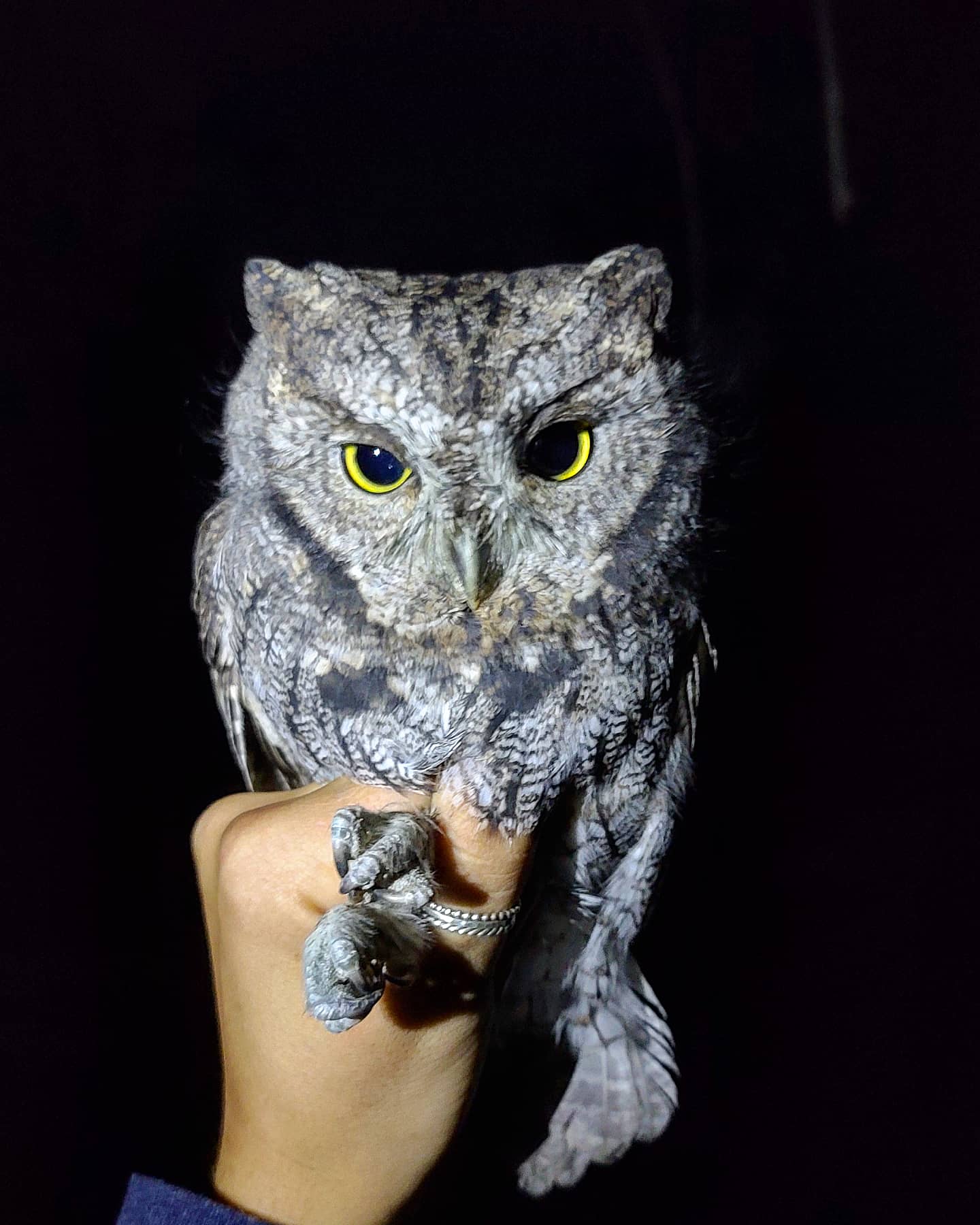
This species generally is found at low elevations, in deciduous trees such as river riparian areas or even urban areas. It is not a rare species but we were surprised that it came up to Lucky Peak. It was only the 7th screech-owl caught at the banding station.
We had a good Northern Saw-whet Owl season too! We caught a total of 367 Saw-whets, four of which were already banded.
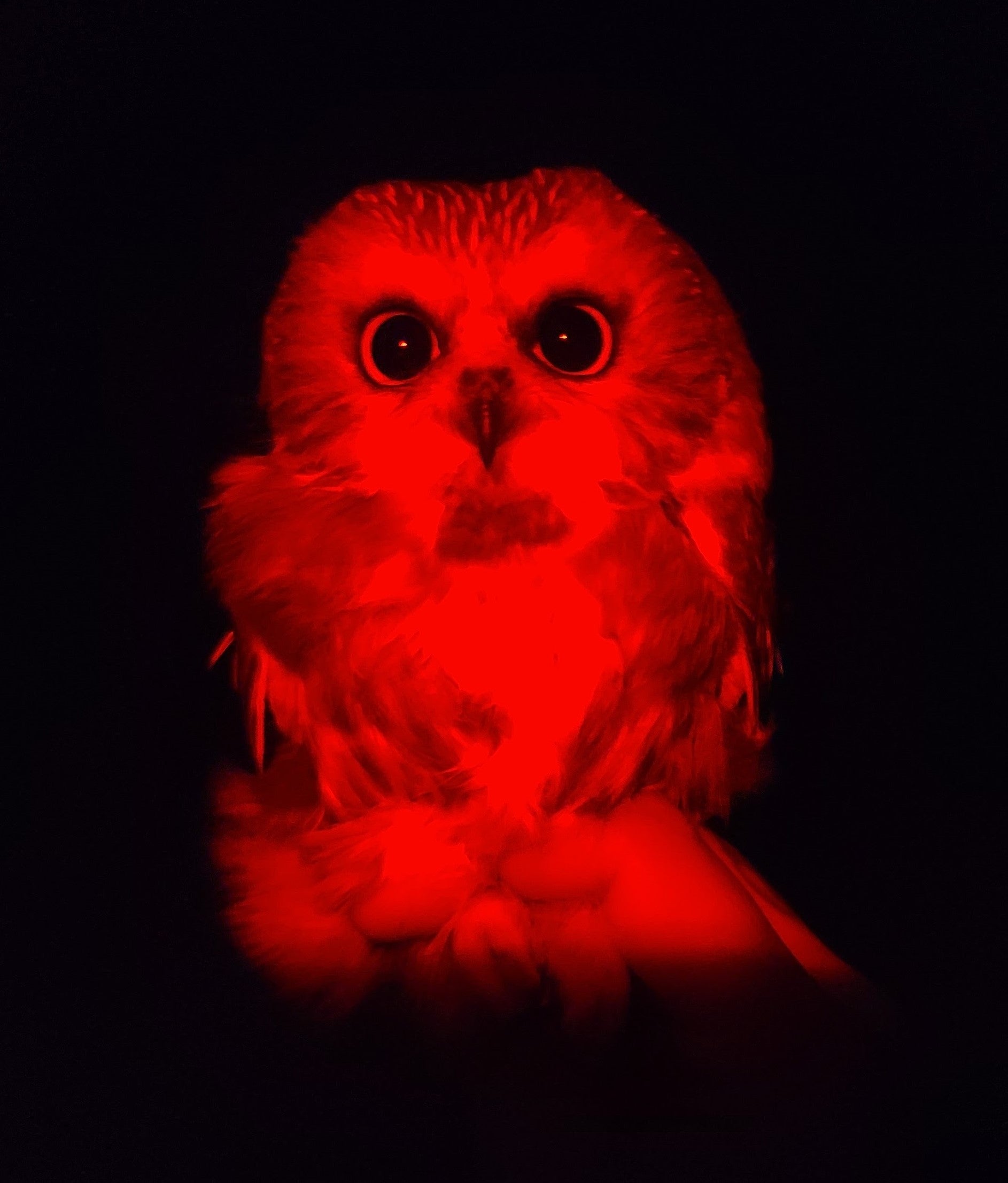
This is above the long-term average of 308 Saw-whets but well below 2020’s mark of 491 or the all-time high set in 1999 of 845. On October 1st, we caught 40 Saw-whets, our highest single-night total. We had almost a week of rain, wind, and snow towards the end of the month, when we caught few birds. But during our last two nights (October 27-29), we caught 25 Saw-whets, indicating that migration wasn’t over yet.
Normally by the end of the season our capture rates are low and we are dodging snowflakes while hurrying to pack up camp before the first big snow risks closing the road for the winter. With the unseasonably warm fall and obvious continuing migration it made it especially hard to pull ourselves away and bid farewell to Lucky Peak for the season!
This article is part of our 2021 end of the year newsletter! View the full newsletter here, or click “older posts” below to read the next article.
Make sure you don’t miss out on IBO news! Sign up to get our email updates.